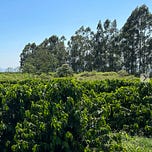Rows of Coffee Trees in Brazil — November14, 2023 — It was 103°F and the trees were drooping a bit
The potential impact of Climate Change upon the production of coffee is the key topic here. The discussion of the climatological factors that imperil the production of coffee is essential; we do this not only to save coffee, but to save ourselves.
But coffee exists in and depends upon many other climates (as do we). Our discourse as an industry ‑ our conversational climate — must also be friendly to coffee and should be supportive of its production.
The economic climate must be healthy enough so that coffee drinkers don’t feel that they can only afford the cheapest and least amount of coffee available. The agronomic climate must also be positive for the production of coffee — coffee might be a more attractive option for farmers today than it was five years ago, but if other crops should become even more promising, the production of coffee could still decrease.
The same holds true for labor — all over the world coffee farmers are reporting that they have difficulty attracting enough workers to maintain their trees and harvest their coffee. Even under the highly mechanized conditions in Brazil, coffee farmers are often unable to sign up enough workers. Further, it’s not just a matter of wages — before accepting jobs, laborers now often insist upon having a signal for their phones all over the farm — it is doubtful that this is only true in Brazil. Today, the pool of potential coffee workers spent their childhood on the internet — many were nearly raised by it — having it always available is not a luxury for them —it fulfills a requirement and matches what many urban employers provide.
Coffee farmers are also finding that if they can provide employment conditions that mimic those of urban work and also recall the interfaces of video games, phones and computers, they can more successfully attract workers. Farming equipment today often looks more “technical” than it really is in order to help younger workers feel more comfortable engaging with it. The adaptation of drones, GPS, and touch screens all have the potential to increase efficiency and productivity, but they can likewise make agricultural work seem more urban — and more desirable.
Coffee, then, fights with other crops, even with prices at relatively high levels, for the labor it needs to show up in the marketplace. It fights with the math that argues for alternative crops (farmers are not rushing to plant coffee in 2025). Alexandre Gonzaga, a Brazilian coffee colleague and coffee agronomist, enumerated five factors that farmers consider before planting coffee (or any other crop):
1) That they will have the labor needed to support and harvest the crop;
2) That they can produce coffee within the time needed for an investment in a coffee crop to make sense;
3) That it is the best possible crop for the land they own;
4) That the climate is and will be suitable for profitable production, and;
5) That the market price is attractive.
Looking at these five factors, even with today’s high prices, and taking them all into consideration at once, it is not clear to many farmers today that coffee is a wise choice. CONAB, the National Supply Company of Brazil, which tracks agricultural data, among other functions, reports that hectares planted to coffee in Brazil decreased 1.6 % from 2024 to 2025. This may not be statistically significant and the currently high prices have likely not been around long enough to influence planting decisions. Yet, even taking that all into account, the fact remains that planted hectares in coffee went down in a record high market. Alexandre points to farmers lately preferring annual crops, including more vegetables — not only have they been consistently profitable, they don’t require the many years of commitment that planting coffee demands. Soy beans, corn and cotton are similarly compelling alternatives to coffee, which, again, requires two to three years of labor and resources before producing its first crop.
The bottom line, then, is obvious — while prices are high, for now, they are not high enough and haven’t been elevated long enough, to motivate a sufficient number of farmers to increase their plantings of coffee in Brazil. Spinning the globe doesn’t reveal another origin likely to fill the breach. Adding to the complexity of the situation is the possibility that current plantings may support a large crop next year, weather permitting, of up to 65 million bags out of Brazil alone. This potential outcome looms less than a year after it wasn’t clear if Brazil’s climate, and therefore the origin overall, might lurch completely away from coffee production in the wake of a epochal shift in its weather.
This is without considering tariffs, and the disruption they’ve caused, and may cause, generally to world trade patterns, much less to coffee specifically. For the time being, we’ve dodged the bullet in terms of suffering a severe climate disruption, but that doesn’t mean that another tectonic shift (using the term only metaphorically — I hope), might not be on the way. As a former* U.S. Secretary of Defense once opined, to paraphrase, these are just some of the known unknowns; the unknown unknowns lurk, for now, beyond our reach. The uncertainty, itself, does not improve any of the various Climates for Coffee.
*Apologies to my readers for perhaps prompting the recollection of the present holder of that title.













Share this post